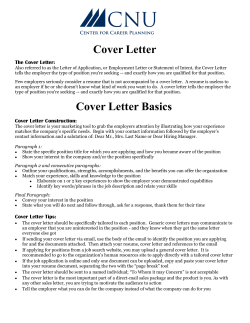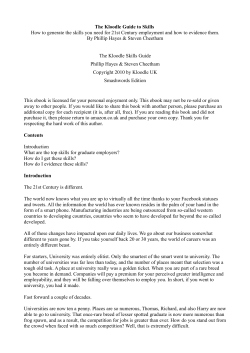
July 24, 2013
Issue Sixty-Nine July 2013 July 24, 2013 The IRS recently released Notice 2013-45 to provide additional details on the delay of the employer reporting requirements and the employer coverage mandate. It is important to understand exactly what is affected by this delay. Reporting Requirements Health care reform added new reporting requirements to the Internal Revenue Code (IRC). These reports are needed to administer the complexities of the employer mandate. Two sections of the IRC address these reporting requirements. Section 6055 applies to health insurance carriers, government agencies, employers that sponsor self-insured plans, and other persons that provide minimum essential coverage to an individual. Section 6056 applies to large employers (50 or more full-time and full-time-equivalent employees). Under Section 6056, large employers are required to provide the following information to the IRS: The name, date and employer identification number of the filing employer. A certification as to whether the employer offers its full-time employees and their dependents the opportunity to enroll in minimum essential coverage under an eligible employer-sponsored health plan. If the employer certifies that full-time employees and their dependents were given an opportunity to enroll, the employer must verify: o The length of any new hire waiting period that applies to coverage o The months during the calendar year when coverage was available under the plan, and the monthly premium for the lowest-cost option in each of the enrollment categories under the plan o The employer’s share of the total premium or cost of benefits that are provided by the plan o The option for which the employer pays the largest portion of the cost of the plan, and the portion of the cost paid by the employer in each of the enrollment categories under the plan Verification of the number of full-time employees for each month during the calendar year The name, address and tax identification number of each full-time employee for each month during the calendar year and any months during which any such employees or dependents were covered by the health benefits The name, address and phone contact information for the person completing the employer return McGraw Wentworth www.mcgrawwentworth.com Issue Sixty-Nine July 2013, Page 2 Large employers under Section 6056 are also required to provide each employee, included in the above reporting, with a written statement containing the following information: The applicable large employer’s name and address The applicable large employer’s contact information Information regarding the coverage provided to that employee and dependents as noted above Initially, the reporting needed to be filed on or before January 31st of the year following the calendar year for which the return is applicable. For 2014, the reporting would have been due by January 31, 2015. Section 6055 and 6056 reporting is being delayed for one year. Reporting will be required for the 2015 calendar year, and will be due by January 31, 2016. Why the delay? The IRS requested comments on the process in 2012, and received significant feedback that this reporting is too complex. While developing the initial guidance, they realized the information may be difficult to obtain, as it is not information that insurance carriers or employers are currently tracking. System or software upgrades may be needed to comply with the reporting requirements. Therefore, the IRS does not believe insurance carriers and employers will have enough time to comply effectively with the requirements. They will request feedback from stakeholders after the initial guidance is released this summer. The IRS is particularly interested in feedback on simplifying the reporting data and process requirements. However, the IRS is encouraging employers and health insurance carriers to comply voluntarily with the proposed regulations on the reporting requirements in 2014. This will allow insurers and employers to work out any glitches in their information tracking before 2015. Employer Mandate – The Play or Pay Requirement The requirement that large employers offer coverage or pay a penalty is often referred to as the employer mandate or “play or pay” requirement. This requirement was expected to apply as of January 1, 2014, with a delay allowed for employers with non-calendar year plans meeting certain requirements. Employers could be assessed one of the following penalties: 1. Penalty for Not Offering Coverage: This penalty applies if, in any month, a full-time employee receives an applicable premium tax credit and the large employer did not offer substantially all (95%) full-time employees (and their dependents) minimum essential coverage under an employer-sponsored health plan. The penalty is $2,000 annually, assessed monthly. It applies to all full-time employees, less the first 30. 2. Penalty for Not Offering Adequate Coverage: This penalty applies if, in any month, employer-sponsored coverage for full-time employees (and their dependents) fails either the minimum value or affordability test for an employee and that employee receives subsidized coverage through the Health Insurance Marketplace. The penalty is $3,000 annually, assessed monthly for each full-time employee that receives subsidized individual coverage in the Marketplace. The total amount is capped at the penalty liability for not offering coverage. McGraw Wentworth www.mcgrawwentworth.com Issue Sixty-Nine July 2013, Page 3 The IRS expected to use employer reporting to determine if an employer owed any penalties under the mandate. Because the IRS will not have this reporting for 2014, no employer penalties will be assessed in 2014. What is Not Being Delayed IRS Notice 2013-45 contains very little detail on the impact of this delay on the other requirements of health care reform. It states broadly that this delay will have no impact on the effective date or application of the other provisions of the Affordable Care Act. Further, it specifically notes that premium tax credits will be available for qualifying individuals in the Marketplace in 2014. It confirms that the individual mandate will still be effective as of January 1, 2014. While more detail would have been appreciated, employers can assume the following requirements of health care reform will remain on schedule: Notice requirements: o Summaries of benefits and coverage o Exchange notice requirement Plan design requirements: o New hire waiting period limited to no longer than 90 days o No pre-existing condition limitations permitted o Required coverage of clinical trials for non-grandfathered plans o Increased incentives and new rules for health-contingent wellness plans o Maximum out-of-pocket limits on non-grandfathered plans (all cost-sharing on essential health benefits must accumulate toward the maximum) o Small group health plan deductible limits ($2,000/$4,000) o Dependent coverage limitation under grandfathered plans must be eliminated Employers will also need to account for the financial impact of: Taxes and fees that are included as part of health care reform. This could include the Patient-Centered Outcome Research (PCOR) fee (also called the CER fee), the temporary reinsurance fee and the insurance carrier market share tax. Employee migration to your health plan. With the individual mandate taking effect on January 1, 2014, employers may see more employees electing coverage in order to avoid the individual tax penalty. Employers may still need to determine if their plan offers a minimum value and is affordable. The Marketplace is likely to contact employers to verify applicants’ eligibility for other coverage. If employees and dependents are offered minimum value, affordable coverage by the employer, then they are prohibited from receiving subsidies in the Marketplace, even if they are otherwise eligible for them. McGraw Wentworth www.mcgrawwentworth.com Issue Sixty-Nine July 2013, Page 4 Other employer issues are less clear. Employers should not have to track variable-hour employees in 2013. They will not need to offer employees working 30 or more hours per week coverage to avoid the penalty. However, they may need to begin measuring these employees during 2013/2014 to determine if they will be eligible for coverage in 2015. The IRS provided no commentary on how this delay may affect any of the transitional guidance they are providing for the measurement of full-time employment. It is uncertain if the transitional guidance for non-calendar year plans will be maintained. Initially, these transitional rules allowed non-calendar year employer plans to comply with the employer mandate on the first day of the plan year beginning in 2014. It is not clear if non-calendar year plans will need to comply with the employer mandates as January 1, 2015 or the first day of their first plan year on or after January 1, 2015. A one-year reprieve is granted to employers that have some employees working 30 or more hours per week, to whom coverage is not currently offered. Employers in this situation should use the delay wisely to continue evaluating their strategy in terms of these employees. Concluding Thoughts There has been significant press on the delay of the employer reporting requirements and the employer mandate. The delay is limited solely to these two requirements. Employers should continue to plan on providing required notices and making necessary plan design changes. In addition, they should budget for 2014 cost increases associated with new taxes and fees. Finally, employers should watch for additional details, and be ready to respond to changes in the health care reform landscape. McGraw Wentworth www.mcgrawwentworth.com
© Copyright 2025





















